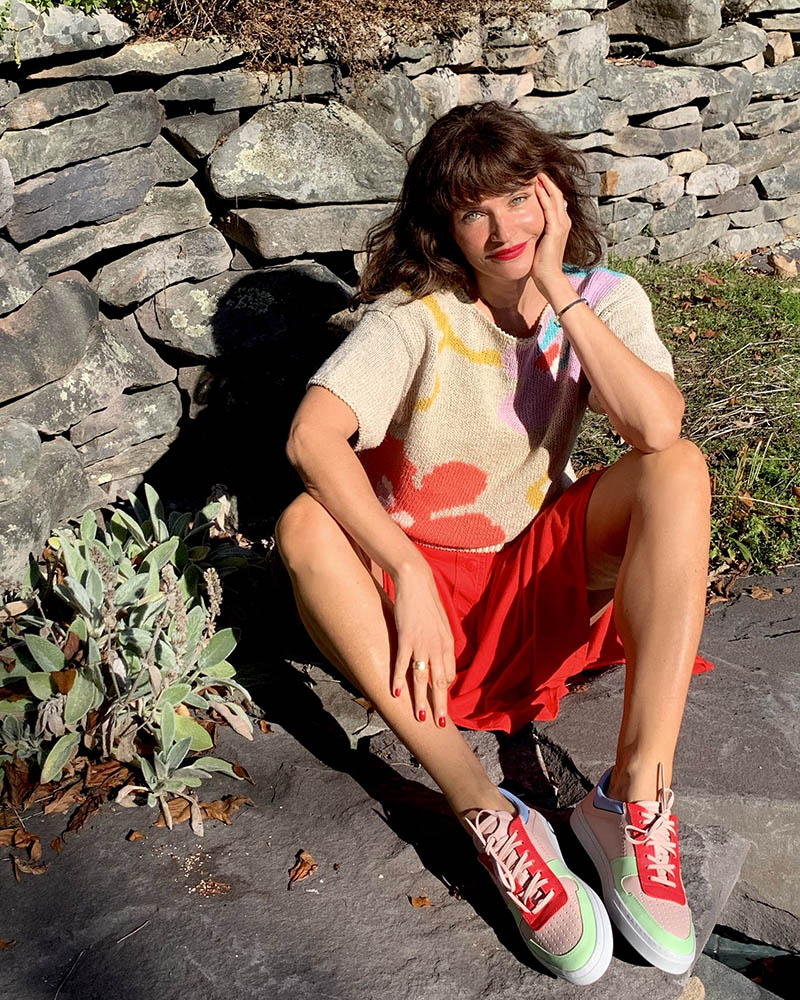Helena Christensen is on a mission to banish single-use plastic from the streets of New York. “I’m the kind of person who will bend down and pick up garbage—90 percent of it is plastic, plastic, plastic,” the Danish supermodel, photographer and environmental activist tells Vogue via phone from her NYC home.
With the plastic crisis only set to worsen due to the pandemic, Christensen has teamed up with non-profit No More Plastic to create an exclusive design for Milan-based vegan sneaker brand Yatay. “Creating fun shoes with Yatay is a great way to get more people involved,” she explains. The plastic-free sneakers are made from bio-based materials, with 50 percent of the profits going to No More Plastic and a tree planted for every sneaker bought.
Christensen has long been outspoken on the environment, photographing the impact of climate change in Peru for Oxfam back in 2009. Since then, she’s entered the world of sustainable fashion, launching Pawn Shop, a curation of vintage and second-hand pieces, with her business partner Camilla Stærk.
Here, we catch up with the supermodel about her new collaboration with Yatay, her insider view on how sustainable fashion has evolved, and why caring for the environment comes so naturally to her.

What drew you to this collaboration between Yatay and No More Plastic?
I’ve been part of No More Plastic for a long time and always supported them in whatever way I could—they’re committed to making change happen. I feel passionate about smaller charities and organisations because they’re basically founded by people like ourselves who, instead of just thinking about making a difference, actually went ahead and took action. I admire Yatay for its approach; it’s a company making a great effort in changing how products are made ethically and environmentally—that’s not easy.
What can we do about the issue of single-use plastic?
Plastic is one place where you can easily make a difference—it has a huge effect environmentally because it doesn’t just disappear. We have to be conscious about switching out plastic; there are so many more environmentally friendly options nowadays. I went grocery shopping the other day and most of the products in the vegetable aisle were all wrapped in plastic. What do you do? You can try finding a local farmers’ market, and get the produce without the plastic.
How have conversations around sustainability in fashion changed during the years that you’ve been in the industry?
I see a lot of the bigger companies making a conscious change, but it started with the small companies that were actually making a difference to the environment. If you’re going to produce more stuff, it needs to be a conscious decision and [you have to have] a responsibility for what you’re putting out there. There should be set regulations for how you manufacture something—that we don’t have laws for something that is so universally important for the entire planet makes no sense to me.
Since launching Pawn Shop, have you noticed vintage and second-hand clothing increase in popularity?
You can see on social media how many people are now selling vintage and secondhand; there is definitely a greater demand. For me, it’s the only way I’ve ever shopped really. It’s rare that I’ll buy anything new. I will look at 20 vintage sites before I get inspired by anything new, and when I do, it’s usually because it reminds me of something vintage. I launched Pawn Shop to clean out my closet and, at the same time, use it for something good [by supporting] small charities. We get the most beautiful letters from people saying they love the pieces, and that they’ll take care of it until they pass it on.
What’s your general approach to sustainability?
For me, having a Danish upbringing made a huge difference. Being environmentally conscious, separating garbage, riding bikes instead of driving cars—that was just the way of life. I’ve taken that into adulthood, whether it’s [energy-efficient] lightbulbs, using less electricity for washing and drying; all the little things that might not seem like a big change individually, but make a huge difference when you add it all up. I mostly take cold showers [which is better for the environment]—it’s good for you and it’s one of those things I have a yearning for.
You’ve been an environmental activist for more than a decade now. Do you think enough is being done to tackle the climate crisis?
It’s tough because [the climate crisis] is so much bigger than we can even comprehend. I didn’t know much about it until I went on these trips [with Oxfam] a decade ago and had scientists with me—I stood in front of glaciers melting; seeing the effects of climate change on the indigenous people in the Peruvian mountains. It was so chilling to see it with my own eyes.
A lot of action has been taken since then, but not enough is being done. [During the pandemic], people have slowed down and said, ‘This new way of living is great,’ being in nature, doing everything in a more holistic way. This is a universal experience that we’re all sharing right now. Hopefully, things will change.





